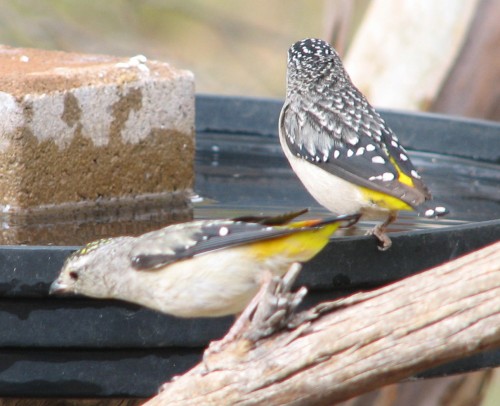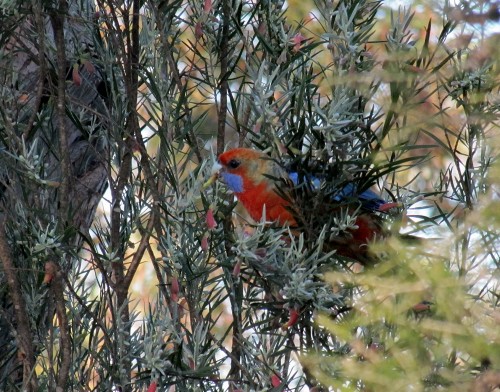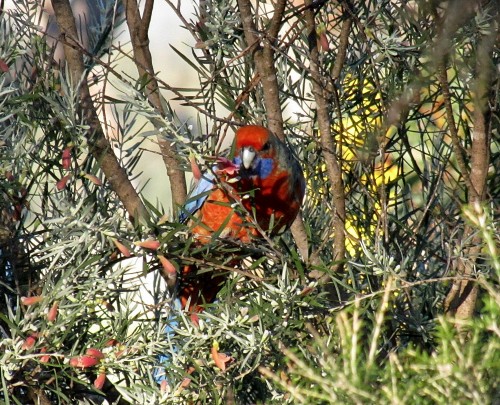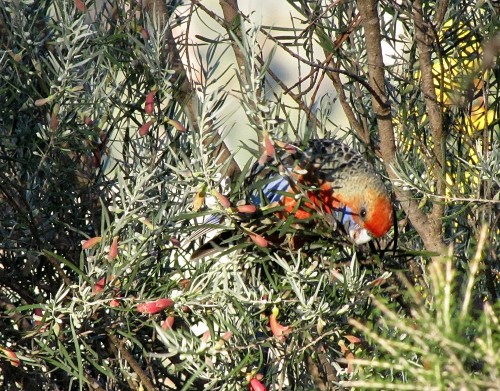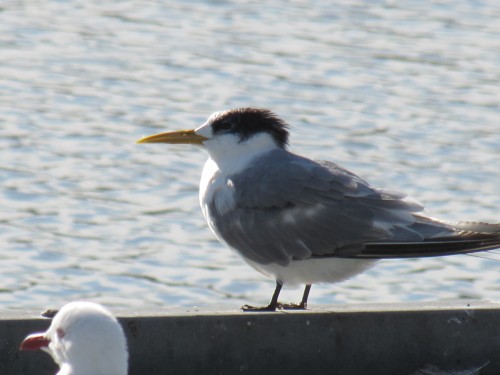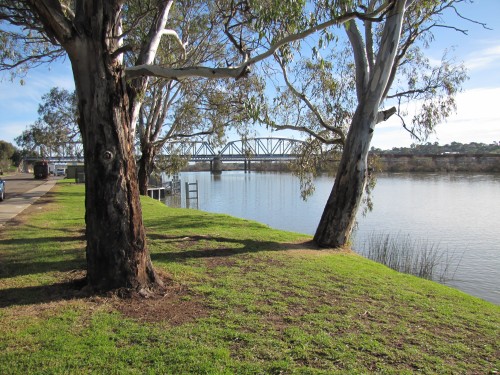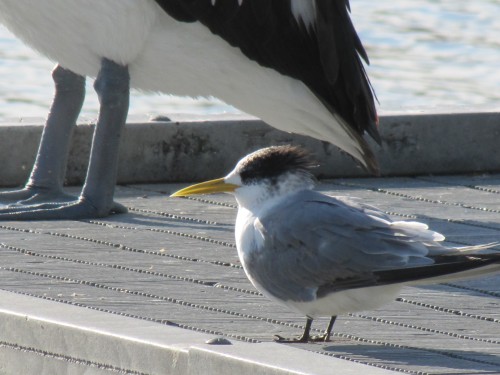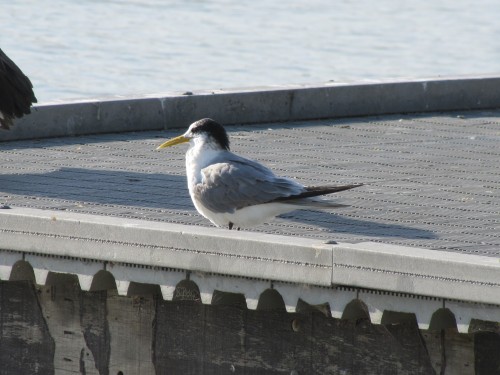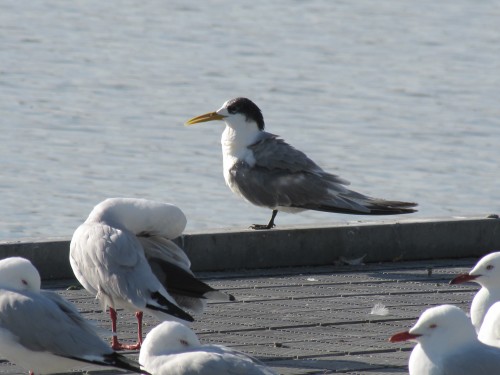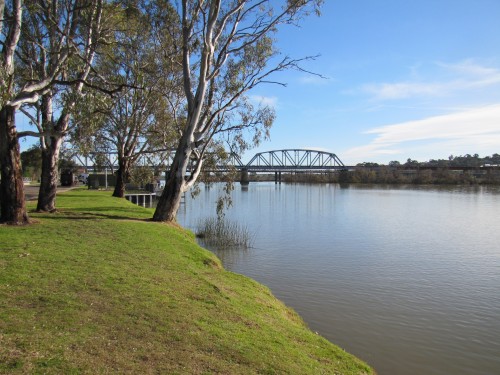Pardalote up close
My regular daily walk takes me along a road bordering our five acre property and then towards a nearby railway line which runs from Adelaide to Melbourne. This road has a reasonable collection of remnant mallee vegetation between the road and the fences along nearby farms and other properties.
On a recent afternoon walk my attention was caught by the movement of a small bird in the roadside vegetation. I stopped to have a closer look, edging to within a metre. A Spotted Pardalote was feeding at a height of about a metre. Totally ignoring me it continued to feed while I watched up close. I admire these beautiful little birds whenever I see them, and their cheerful chirping in our garden is always welcome.
I usually don’t take my camera on these walks, so I’ve included a photo I took some time ago of two of this species visiting one of our birdbaths in our garden.
Perhaps I should get into the habit of taking my camera on my walks because I’ve missed some excellent photo opportunities in recent weeks.
Magpies up close and personal
I was working at our picnic table on our back veranda yesterday. I was marking a brilliant essay written by one of my uni students; she obviously listened well to my lectures and absorbed all the important points. Either that – or I’m a good teacher. The house was cold after a frosty night and the table was bathed in beautiful winter sun. I decided to take advantage of the sun while it lasted.
Half way through my work one of our resident Australian Magpies – a brilliantly coloured male – flew in, perched on one of the chairs and then onto the table where he proceeded to strut around in front of me, not more than a half metre from where I sat. He was obviously looking for bread crumb scraps left over from our lunch.
He stayed for several minutes before a juvenile bird joined us, sitting on the BBQ a few metres away. A sudden squawk from other magpies in the orchard startled them both into action, and they flew off rapidly in that direction.
Pity I didn’t have my camera with me.
Never mind – a similar incident happened to us last year near Mildura when we were having a roadside picnic. On that close encounter, the birds did score a few crumbs from our biscuits – and nearly nabbed a whole one from the biscuit tin left open on the table. The photo below was taken on that occasion.
Adelaide Rosellas in our garden
In our garden and five acre block of land on the outskirts of Murray Bridge in South Australia we have many different species of birds – over 100 in fact. Of those that are resident or occasional visitors we have a good range of parrots.
Perhaps the most abundant would be the Galah, a very common species in the district with flocks numbering in the many hundreds. Another common species is the Little Corella but this is usually a species which only flies overhead, also in large numbers. Other parrots present in smaller numbers include Rainbow Lorikeets, Purple-crowned Lorikeets and Sulphur-crested Cockatoos. Mallee Ringnecks are a resident breeding species. One individual keeps company with an Eastern Rosella, a species not normally present around here (I suspect it is a cage escape.)
Every month or so we have a short visit from several Adelaide Rosellas, shown in today’s photos. This is a sub-species of the Crimson Rosella of the eastern states. The Crimson Rosella is a much deeper red colour, while the Adelaide Rosella is more of an orange colour. In the northern parts of its range in South Australia (eg the lower Flinders Ranges) the orange colour can be quite washed out.
The birds which came to visit us last week are much brighter red than most Adelaide Rosellas, leading me to think that they may be moving north from the South East districts of South Australia where the more brightly coloured birds occur. Just a theory. On the other hand, I don’t have to travel too many kilometres west to see the typically washed out orange rosellas common in the Adelaide region.
Crested Tern, Sturt Reserve, Murray Bridge
As regular readers of this site would know, I live in the rural city of Murray Bridge in South Australia. Our city straddles Australia’s largest waterway, the Murray River. Last week I took an hour out of my busy schedule to take a few photos of birds at Sturt Reserve, named after the early explorer, Charles Sturt who sailed past this spot in 1830.
One of the birds I photographed on the small jetty in the reserve was a Crested Tern. This part of the river is probably about 100km upstream from the river mouth (I’m guessing) but we have several bird species more common along the coast venture upstream this far, including the Crested Terns and the Caspian Terns.
Welcome to readers of the Murray Valley Standard
Welcome to all of those readers who have come to this site as a result of reading the article in today’s Murray Valley Standard newspaper. I am pleased that you made the effort and hope you enjoy my articles and photos about birds.
This site is about sharing my interest in Australian birds seen in our garden here in Murray Bridge, along the river and other places throughout Australia whenever I get the chance to travel. Some of my articles also include photos of birds seen on various overseas trips, the latest being recently in Ethiopia, Morocco and Spain. Many of these photos will continue to appear over the coming months.
Comments
My sites are all interactive, meaning that readers can leave comments. Just click on the link that says “comments” just under the heading of this article (above and to the right of the photo above). I’ll respond to as many as I can.
If you want to find out more about me, click here (the link takes you to my writing site).
If you want to read about my travels, including overseas, click here. That site also includes many photos.
